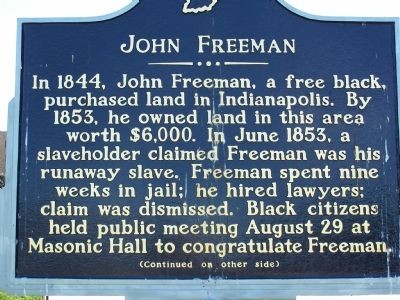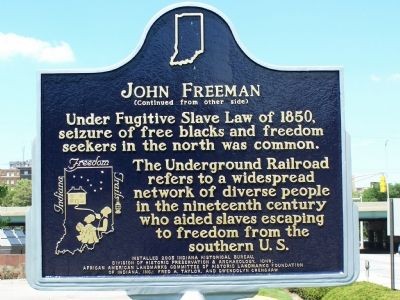John Freeman Historic Marker
Introduction
Text-to-speech Audio
Images
John Freeman Historic Marker - Side 1 (image from Historical Marker Database)

John Freeman Historic Marker - Side 2 (image from Historical Marker Database)

Backstory and Context
Text-to-speech Audio
About John Freeman
Freeman moved from Georgia to Indianapolis in 1844. Starting with $600 in his new bank account, he worked as a house painter until he saved up enough to buy his first four acres of land (at present-day Capitol and Michigan Streets) [1; 2]. He married, had three children, actively participated in the local African American Baptist church and its community service projects, and built up $6,000 worth of real estate over the next nine years [2].
In 1850, the Fugitive Slave Law was passed to pacify Southern slave states, requiring runaway slaves to be returned to their former states and masters should they reach the North. All the proof required against a free African American was an affidavit by the claimant, and no jury trial was offered. Intervening on behalf of a claimed slave could result in criminal charges and jail time. On June 20, 1853, John Freeman was arrested as "Sam", the alleged runaway slave of Pleasant Ellington, a St. Louis Methodist minister. Friends of Freeman convinced Indianapolis Commissioner Squire Sullivan to allow him a trial. Indianapolis lawyers John L. Ketcham, Lucian Barbour, and John Coburn worked for Freeman's defense, while L. D. Walpole and J.A. Liston worked for the prosecution. A nine-week postponement was granted to the defense, but Sullivan refused Freeman's bail, in spite of the open support of prominent leaders, including a judge, for the defendant. Freeman spent the nine weeks in jail and had to pay a daily fee for the jailer who kept him hostage. Meanwhile, Freeman directed his lawyers to witnesses in his home state of Georgia to confirm that he had been a free man from 1831-1844. The real escaped slave, Sam, was found in Canada, going by the name of William McConnell. McConnell agreed to come to Indianapolis for the trial, in spite of the danger to himself [2].
When Ellington's three witnesses requested an examination of
Freeman's naked body to confirm his identity, the defense objected. Newspaper
reports of Deputy Marshal Robinson's compliance with the prosecution, over the
objections of Freeman and his lawyers, and his forcing of Freeman to strip
naked in front of Ellington's witnesses, caused public outrage—one town even
burned an effigy of the Marshal. Whether because of this outrage or because of
mounting evidence in Freeman's favor, Ellington fled Indianapolis before the
trial and the case was dismissed [2]. Freeman was congratulated by a group of African
American citizens at an August 29th meeting at the Masonic Hall [1]. Freeman's
lawyers dropped all fees, but the cost of transporting the witnesses to
Indiana, combined with the fee for his jailor, deprived Freeman of his life
savings. He brought civil suits against Ellington and Robinson; he won the suit
against Ellington, but by then Ellington had sold his St. Louis home and
disappeared. A technicality over the Marshal's county of residence blocked the
suit against Robinson in 1855. Freeman sold most of his real estate, keeping
his house and garden thanks to donations from churches in Indiana and Georgia.
When the Civil War broke out, Freeman and his family moved to Canada [2].
